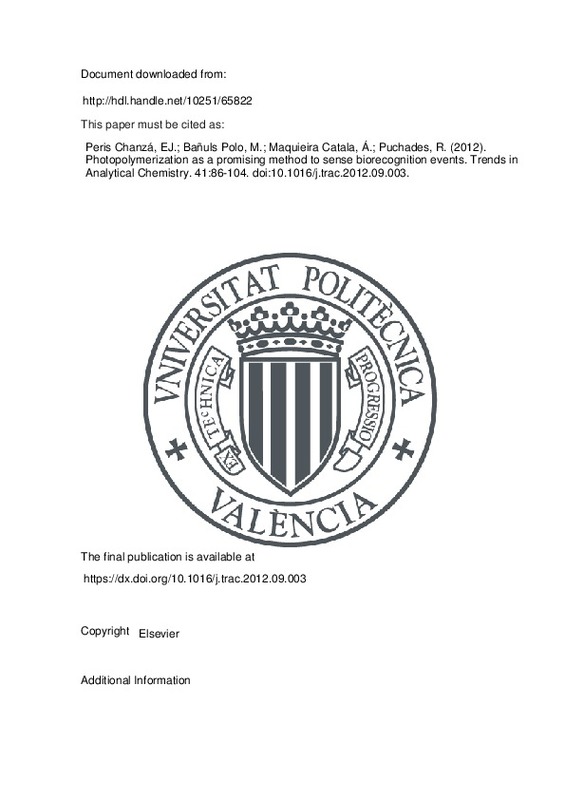Peris Chanzá, EJ.; Bañuls Polo, M.; Maquieira Catala, Á.; Puchades, R. (2012). Photopolymerization as a promising method to sense biorecognition events. Trends in Analytical Chemistry. 41:86-104. https://doi.org/10.1016/j.trac.2012.09.003
Por favor, use este identificador para citar o enlazar este ítem: http://hdl.handle.net/10251/65822
|
Título:
|
Photopolymerization as a promising method to sense biorecognition events
|
|
Autor:
|
Peris Chanzá, Ernesto José

 Bañuls Polo, María-José
Bañuls Polo, María-José

 Maquieira Catala, Ángel
Maquieira Catala, Ángel
 Puchades, Rosa
Puchades, Rosa
|
|
Entidad UPV:
|
Universitat Politècnica de València. Departamento de Química - Departament de Química
Universitat Politècnica de València. Instituto de Reconocimiento Molecular y Desarrollo Tecnológico - Institut de Reconeixement Molecular i Desenvolupament Tecnològic
|
|
Fecha difusión:
|
|
|
Resumen:
|
[EN] This work addresses the main topics related to the photopolymerization process to develop and to monitor the analytical signal derived from biorecognition assays. We review basic aspects of photopolymerization, together ...[+]
[EN] This work addresses the main topics related to the photopolymerization process to develop and to monitor the analytical signal derived from biorecognition assays. We review basic aspects of photopolymerization, together with the nature and the reactivity of the chemicals involved. Focusing on DNA and protein determination and medical applications, we envisage as relevant photopolymers that generate biocompatible hydrogels. We also review the major characterization techniques applied to ascertain the composition of the products formed and to monitor the progress of the reaction. In this sense, we present optical microscopy, fluorescence imaging, ATR-FTIR spectroscopy and profilometry measures.Finally, we discuss analytical examples and applications of protein-to-protein, protein-to-antigen and DNA-hybridization photopolymerization. We demonstrate implementation of CD/DVD player technology to the detection and quantitation of such biointeractions, highlighting the advantages of this powerful methodology in biosensing. © 2012 Elsevier Ltd.
[-]
|
|
Palabras clave:
|
Amplification
,
ATR-FTIR spectroscopy
,
Biorecognition assay
,
Biosensing
,
Characterization
,
Fluorescence imaging
,
Initiator
,
Molecular recognition
,
Photopolymerization
,
Protein determination
,
ATR-FT-IR spectroscopy
,
Biorecognition
,
Assays
,
Fluorescence
,
Fourier transform infrared spectroscopy
,
Initiators (explosives)
,
Medical applications
,
Optical microscopy
,
Photopolymers
,
Polymerization
,
Proteins
,
Monomer
,
Photoinitiator
,
Analytic method
,
Chemical composition
,
DNA determination
,
DNA hybridization
,
Infrared spectroscopy
,
Molecular interaction
,
Priority journal
,
Reaction analysis
,
Review
|
|
Derechos de uso:
|
Reserva de todos los derechos
|
|
Fuente:
|
Trends in Analytical Chemistry. (issn:
0165-9936
)
|
|
DOI:
|
10.1016/j.trac.2012.09.003
|
|
Editorial:
|
Elsevier
|
|
Versión del editor:
|
https://dx.doi.org/10.1016/j.trac.2012.09.003
|
|
Código del Proyecto:
|
info:eu-repo/grantAgreement/MICINN//CTQ2010-15943/ES/ESTUDIO DE NUEVAS VIAS DE DESARROLLO DE BIOMEMS PARA SCREENING MASIVO. DEMOSTRACION DE CONCEPTO COMO HERRAMIENTA DE ANALISIS APLICABLE EN "OMICAS"./
info:eu-repo/grantAgreement/GVA//PROMETEO%2F010%2F008/
info:eu-repo/grantAgreement/UPV//PAID-05-10/
|
|
Agradecimientos:
|
This work was funded by the projects FEDER CTQ2010-15943 (CICYT, Spain), PROMETEO 2010/008 (Generalitat Valenciana), and interdisciplinary UPV PAID 05 - 10 grant.
|
|
Tipo:
|
Artículo
|







![[Cerrado]](/themes/UPV/images/candado.png)


